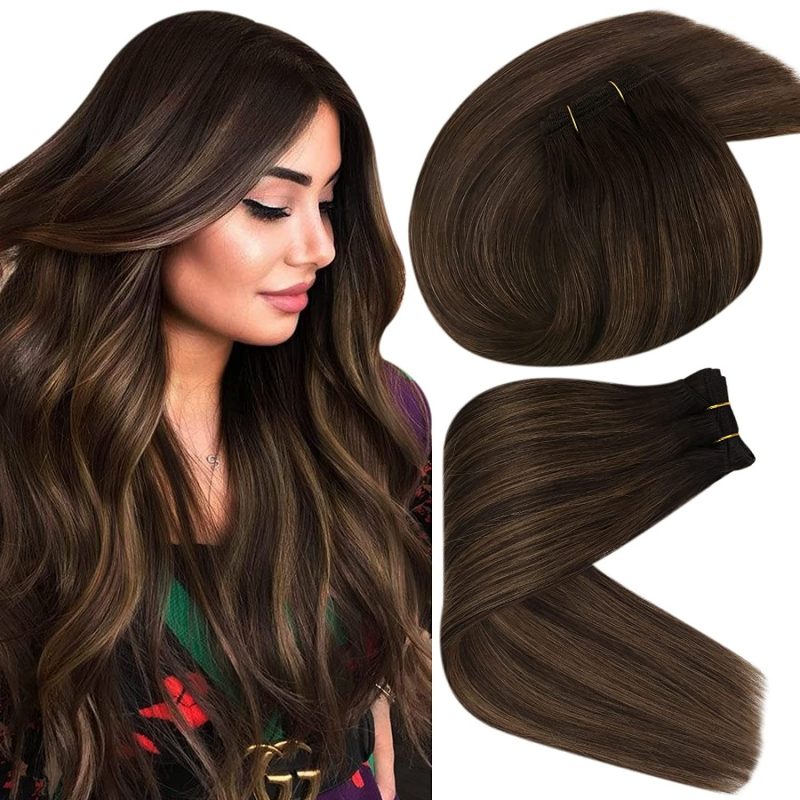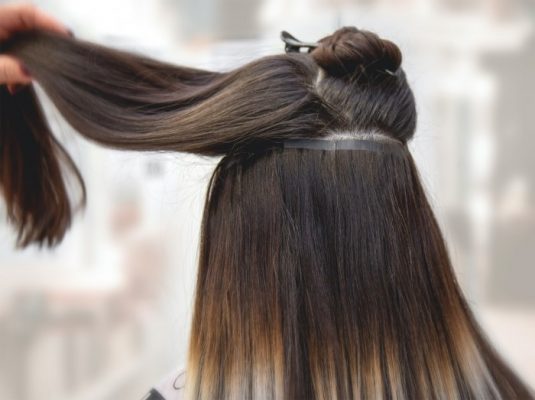Tape-In Hair Extensions: The Ultimate Beginner’s Guide
Main contents
Numerous girls and women fantasize of changing their natural hairstyle to one that is longer, fuller, more voluminous, and even highlighted. Applying hair extensions is the most typical approach to accomplish this. There are many different types of hair extensions, but if you want thick, voluminous hair that lasts a long time, tape in hair extensions are the way to go! In this essay, we’ll tell the truth about these amazing tape-in hair extensions. Let us see what we can find!
An illustration of the use of tape in hair extensions

Hair strand extensions affixed to adhesive tabs are known as tape in hair extensions. These tabs are similar to medical-grade adhesives for closing wounds and surgical incisions.
Tape-in hair extensions come in a variety of lengths, styles, and colors to fulfill the needs of a wide range of clients. Tape in hair extensions are incredibly popular and have become a must-have item for hair enthusiasts due to its exceptional quality and advantages.
In today’s beauty market, tape-in extensions are quickly becoming one of the most popular hair extension procedures. Tape-in extensions are a great way to add length and volume to your hair without causing harm like other semi-permanent extension treatments. Bombay Hair is manufactured from 100% virgin remy hair, which is the best grade hair available. The extensions are made to blend in with your hair and blend in completely.
The advantages and disadvantages of using tape in hair extensions

Advantages of Tape for Hair Extensions
It’s comfortable to apply and take off
Tape-in hair extensions are regarded for being simple and quick to apply. It just takes approximately 30 minutes and doesn’t necessitate the use of any hot equipment or chemical materials. As a result, it does not necessitate the use of a skilled attachment method. Customers can apply tape-in hair extensions on their own or with the help of a hair specialist.
In addition, removing tape-in hair extensions is simple. Users just apply a specific solvent straight to the tapes and then easily remove the tapes from their natural hair. Tape in hair extensions are a popular hair accessory among women because of its ease of use in both application and removal.
Hairstyles that don’t harm your hair
As previously said, the installation and removal of tape in hair extensions do not place any strain on the scalp or cause natural hair to become fragile, making tape in hair extensions one of the most hair-friendly extensions.
If you enjoy changing your hairdo on a regular basis, tape in hair extensions are a good option. You can safeguard your natural hair by causing no hair damage. You don’t have to be concerned about harming your natural hair when experimenting with alternative hairstyles.
Appearance: natural
Tape-in hair extensions are fastened to little, thin tabs that fit in with your natural hair and scalp. Tape in hair extensions are significantly more perfectly blended than other extensions such as clips in or weft hair, blending with your own hair in a smooth and natural way. As a result, if you have fine hair, tape-in hair extensions are a must-have.
A pleasurable experience
Tape-in hair extensions are very flat and light, and they don’t require all-over installation, so they won’t put any strain on your scalp or natural hair. As a result, clients who use tapes continue to feel at ease. They may even forget they are wearing tape in hair extensions at times.
The disadvantages of using tape in hair extensions
Wearing time is reduced
Because tape-in hair extensions are put straight to your roots, they can be seen after a few weeks as your natural hair grows in. Customers must schedule an appointment with a hairdresser 6 to 8 weeks following installation to have the extensions removed and then reinstalled.
Change your hair care regimen
Hair extensions, especially tape in hair extensions, can be damaged by regular washing. They should not be washed with silicone or sulfate products too frequently. A dry shampoo will be a preferable option than washing tape in hair extensions with water.
Hair extension tape has a long history
Extensions using human hair tape

Tape-in hair extensions made of human hair are known as human hair. Human hair is separated into three categories based on the origin of the hair material: virgin hair, Remy hair, and non-Remy hair.
+ Virgin hair is hair that has only been gathered from one person. Virgin hair has not been subjected to any chemical processing, preserving its natural color, consistency, and silky feel. Because virgin hair is considered a luxury hair material, tape-in hair extensions made of virgin hair can bleach to a light hue and will be sold at a high price.
+ Remy hair is sourced from a variety of sources. The uniformity of the texture isn’t as good as virgin, but the quality is still assured. Except for 613, tape-in hair extensions manufactured with Remy hair may be coloured in a variety of tones. Because of its exceptional quality and low cost, tape-in Remy hair extensions are incredibly popular.
+ Non-Remy hair is gathered in large quantities from a large number of people. Hair strands’ cuticles do not all point in the same direction, resulting in poor product quality. Non-Remy tape in hair extensions is not preferred by many individuals since it is delicate, easily tangled, and sheds. Non-Remy hair extensions will be sold at a reduced cost because of their low quality.
Extensions made of synthetic hair tape

Synthetic hair, on the other hand, refers to artificial hair strands produced from nylon or acrylic. They were subjected to a variety of chemical treatments in order to obtain color and the appearance of actual human hair strands. Although synthetic tape in hair extensions appears to be sleek, smooth, and silky, they cannot provide consumers with the same natural look as virgin tape in hair.
Synthetic tape is also known to have a short lifespan when used in hair extensions. Customers are unable to handle synthetic tapes as they would their own real hair, causing them to get tangled, matted, and hence undurable.
Tape-in hair extension instruction
Because the installation process for tape in hair extensions is semi-permanent, it doesn’t take a lot of complicated ability, so you may go to a hair salon or do it yourself. We’d like to show you how to put tape-in hair extensions in the right spot. I wish you well in your quest for a stunning appearance.
Step 1: Separate your hair horizontally right above your ears using a section of your hair.
Step 2: Double-check that a portion has been chosen.
Step 3: Tape one piece of hair extension beneath sectioned hair around 14 inches from the scalp, then peel off the tape cover.
Step 4: Go over the tape area with a comb to make sure it’s flat.
Step 5: Apply a second tape hair piece strip to the underparts and press firmly.
Step 6: Using figures, apply pressure for 5-10 seconds to attach two tape wefts held together.
In Conclusion
Hair extension factories that use qualified tape get rave feedback from foreign clients. Fake reviews, on the other hand, should be avoided. Real evaluations come from real people, and they’re accompanied by compelling photographs and videos. Cyhair’s hair extensions for Tape-In Hair are assured to be of high quality owing to the company’s manufacturing experience. They also provide a wide range of products to meet the demands of clients all around the world. They are a reliable and appropriate location for any end-user, hair company reseller, or wholesaler seeking for the greatest deal.
Contact Us:
+ Whatsapp: +84387751243
+ Email: leeanh@cyhair.vn


Pingback: How Long Do Sew-in Hair Extensions Last? | CYHAIR
Pingback: The best places to purchase Remy hair extensions | CYHAIR